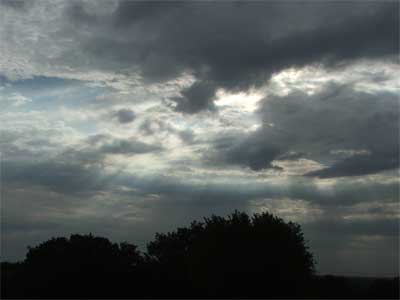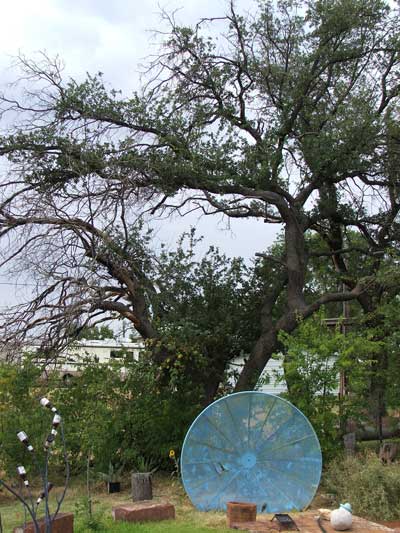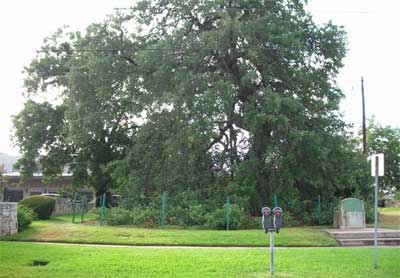Native Son – July, 2011

A new day promises new discoveries. Photos by Steven Chamblee.
Listening to Trees
A fancy tour bus full of visitors pulls up in front of Chandor Gardens. Normally, I would be a bit more enthusiastic at such a wonderful sight, but to tell you the truth … well, I am just hot. Just like everyone else who works outside, I’ve grown tired of being hot and tired … and hot. Wears on you after a while, ya know? So here I am, wearing a solid color button-up shirt that looks like it’s tie-dyed because of the crazy sweat pattern, hopping into the bus to give a hearty, “Welcome to Chandor Gardens!” Nobody reacts. A woman in the front of the bus performs a rapid-fire sign language interpretation and the crowd comes alive. Well, I’ll be … 104 in the shade, and a group of deaf senior citizens has arrived at the garden. You just never know what the sunrise will bring.
Ninety minutes later, my new friends are departing for other places, other adventures, other discoveries. I leak a tear or two as the bus rolls away. Thirty-seven people who share a common language have rocked my world. We’ve laughed together, learned together, shared together. The koi did the feeding frenzy, lizards darted in and out of sight, a butterfly landed upon some auburn hair. Several of us did an impromptu waltz in the middle of the garden to music that only we could hear. When the hummingbird zipped by, a few ladies squealed like little girls. My shirt was sweaty but they hugged me anyway. I’m not so sure I would have hugged me! Hmmm … doesn’t seem that hot any more….
Five hours later, looking out my dining room window, I see the remnants of a once-grand live oak. Originally part of a cluster of about a dozen oaks that surrounded my house, it is the only one that survived the oak wilt disease that rolled through here back in 2000, six years before I moved in. To add insult to injury, the tree is badly disfigured from a wildfire in 2008. Technically still alive, its former glory is no more, and the gracefully arching limbs now seem more like a broken skeleton than a tree.

"Helen," the author’s live oak, has survived an oak wilt outbreak and a wildfire.
After the fire, several people encouraged me to “face the facts,” judge her worthless, cut her down, and start over. Truthfully, I probably would have done so if I had more time or a small pile of insurance money to “clean things up properly.” But life kept me busy and the insurance people only seemed interested in a tree that had been sawn into a tidy stack of lumber. I was a little miffed about that at first, but now I see it as some sort of divine intervention. Almost two years later, inward toward the trunk, epicormic (beneath the bark) buds broke dormancy, and new branches grew out vigorously, giving hope for the future. When she was perfect, she was simply another beautiful tree. But now, she is something else. I named her “Helen,” after Helen Keller, a brave woman who rose above seemingly insurmountable odds to live a life of great value.

Growth from the disfigured tree gives hope for the future.
Helen is my tree, but she really isn’t … she belongs to the world. She was in this world before I was, and she’ll likely be here after I’m gone. We are sharing this time and space together for a little while, just like my friends, my family, my countrymen. I think about how much has happened to both of us since Y2K — how we’ve both been laid pretty low but are still green and growing.

Austin’s Treaty Oak today.
Upon reflection, Helen’s story seems to parallel the story of Austin’s Treaty Oak. Originally part of a group of 14 massive, 500-year-old trees named the Council Oaks, it was once named the most perfect tree in the country. Today, it is the sole survivor of the group and severely disfigured. When the Treaty Oak was deliberately poisoned back in 1989, it was expected to die. Economically, the solution was clear: cut it down, clear it away, and move on with life. But the atrocity touched deep into the heart of many Texans who never thought for a minute that the easy solution was the right one. They saw the innate value in the tree, as well as its connection to history. Thanks to the heroic efforts of dozens of people and the moral support of millions more, the Treaty Oak still stands today. Indeed, it got a helping hand when it needed it the most — a second chance at life.
To some folks, the Treaty Oak serves as a reminder of the Native Americans who once met under the Council Oaks. To other people, it serves to honor the power of a community coming together to work for a common cause, in this case, to right a wrong. But to me … well, I tend to take most everything personally. So the tree reminds me of something my mother taught me: “Life isn’t fair, so no matter what it dishes out, you need to keep going and work your way through it.” These are comforting words for a garden guy going through a double-whammy heat wave and drought.
All of this brings me to thinking about the people of Texas, and how we’re all in the same high and dry boat with the drought. We’re all suffering through this thing together, but if we choose to, we can make the most of it. Sometimes we can nurture ourselves by nurturing someone or something else, like the Treaty Oak. Sometimes we just need to let something be for a while, like Helen. Sometimes we just need to reach out, listen in a new way, or hug a sweaty shirt. Nurture … endure … and for cryin’ out loud, mulch!
Peace & Love,
Steven
— Just for clarity — Helen is not immune or resistant to oak wilt … no live oak is. For whatever reason, she simply did not get infected with the disease as the surrounding oaks did. When this drought has ended, she will get an injection of nutrients and a fungicide to protect her against oak wilt in the future.
About the author: Steven Chamblee is the chief horticulturist for Chandor Gardens in Weatherford and a regular contributor to Neil Sperry’s GARDENS magazine and e-gardens newsletter. Steven adds these notes:
Make sure your summer’s not a bummer. Head out to Chandor Gardens for a stroll in the shade. Just take I-20 west to exit 409, hang a right, go 2.1 miles and hang a left on Lee Avenue. Head straight 12 blocks and you’re driving in the gates. Call 817-361-1700 for more information. You can always go to www.chandorgardens.com for a picture tour and more information.
I can always use another road trip! Let me know if you’d like me to come out and speak to your group sometime. I’m low-maintenance, flexible, and you know I like to go just about anywhere. No city too big; no town to small. Just send me an e-mail at schamblee@weatherfordtx.gov and we’ll work something out.

